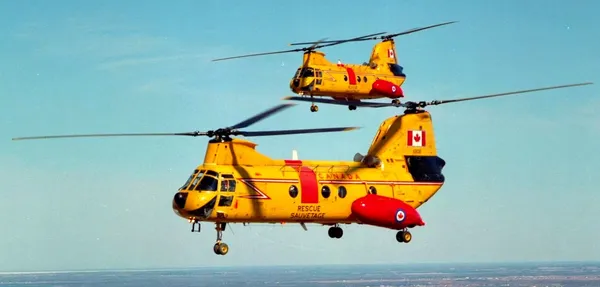Boeing CH-113 Labrador (RCAF)/Voyageur (Army)

Boeing Vertol CH-113 Labrador (Serial No. 11302), in formation.
The Boeing Vertol CH-113 Labrador was the RCAF Search and rescue version of the American Model 107-II-9 (CH-46) Sea Knight helicopter. The CH-113A Voyageur was the Canadian Army Assault and utility transport version of the Model 107-II-28 helicopter, later converted to CH-113A Labrador.
The RCAF procured six CH-113 Labrador helicopters for the SAR role and the Canadian Army acquired 12 of the similar CH-113A Voyageur for the medium-lift transport role. The RCAF Labradors were delivered first with the first one entering service on 11 October 1963. When the larger CH-147 Chinook was procured by the Canadian Forces in the mid-1970s, the Voyageur fleet was converted to Labrador specifications to undertake SAR missions. The refurbished Voyageurs were re-designated as CH-113A Labradors, with a total of 15 Labradors ultimately in service.
The Labrador was fitted with a watertight hull for marine landings, a 5,000 kilogram cargo hook and an external rescue hoist mounted over the right front door. It featured a 1,110 kilometer flying range, emergency medical equipment and an 18-person passenger capacity. By the 1990s, heavy use and hostile weather conditions had taken their toll on the Labrador fleet, resulting in increasing maintenance costs and the need for prompt replacement. In 1981, a mid-life upgrade of the fleet was carried out by Boeing Canada in Arnprior, Ontario. Known as the SAR-CUP (Search and Rescue Capability Upgrade Program), the refit scheme included new instrumentation, a nose-mounted weather radar, a tail-mounted auxiliary power unit, a new high-speed rescue hoist mounted over the side door and front-mounted searchlights. A total of six CH-113s and five CH-113As were upgraded with the last delivered in 1984. The last CH-113 was retired in 2004. Harold A Skaarup Web Page
 Wikipedia Boeing Vertol CH-46 Sea Knight
Wikipedia Boeing Vertol CH-46 Sea Knight
 YouTube Labrador Helicopter Boeing Vertol SAR Search and Rescue Demo 1995
YouTube Labrador Helicopter Boeing Vertol SAR Search and Rescue Demo 1995
CASPIR Aircraft Groups:
RCAF On Strength (16), Canadian Aircraft Losses (4)Labrador/Voyageur CH-113A 10411
No. 1 Transport Helicopter Platoon, RCASC, based at CJATC, Rivers, Man. Operational by January 1965. To Europe onboard HMCS Provider in 1967, for exercises in Germany. Visited CFB La Macaza, Quebec in September 1968, probably with St. Hubert detachment of 450 Squadron at this time. Later with 450 Squadron at CFB Uplands, Ontario.
From 11311
Converted to SAR configuration Labrador 1975. With 103 Rescue Unit, CFB Gander, Nfld, in 1982 and 1983. Also reported with 413 Squadron at Summerside in 1982 and 1983. Serving with 442 Squadron at CFB Comox, BC at time of crash. Was hoisting stranded hikers when engine failure at high altitude caused crash at 5,000 foot level in mountains near Bella Coola, Vancouver Island. One fatality, Cpl. P.L.C. Young.
1964-12-02 Taken on Strength 2019-08-20
1971-11-19 Serial Change Became CAF 11311 2019-08-20









 Canadian Virtual War Memorial
Canadian Virtual War Memorial Sydney, Nova Scotia
Sydney, Nova Scotia Harold A Skaarup Web Page
Harold A Skaarup Web Page Accident Report
Accident Report




